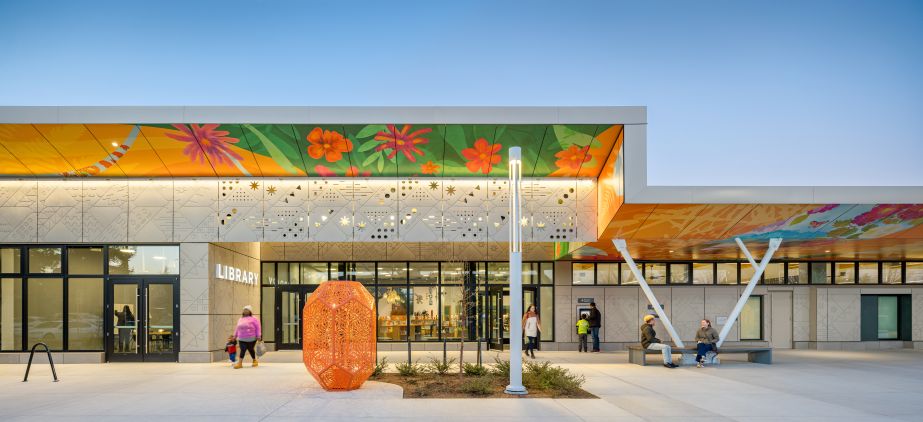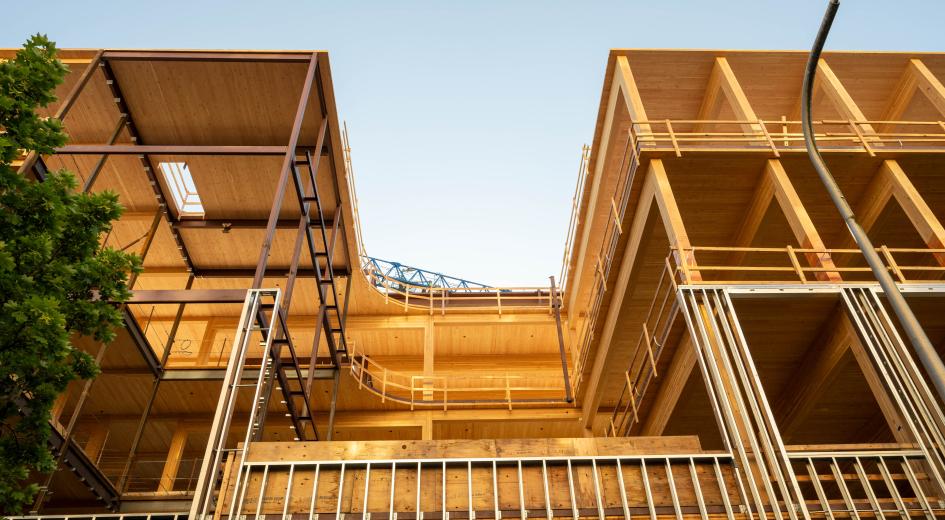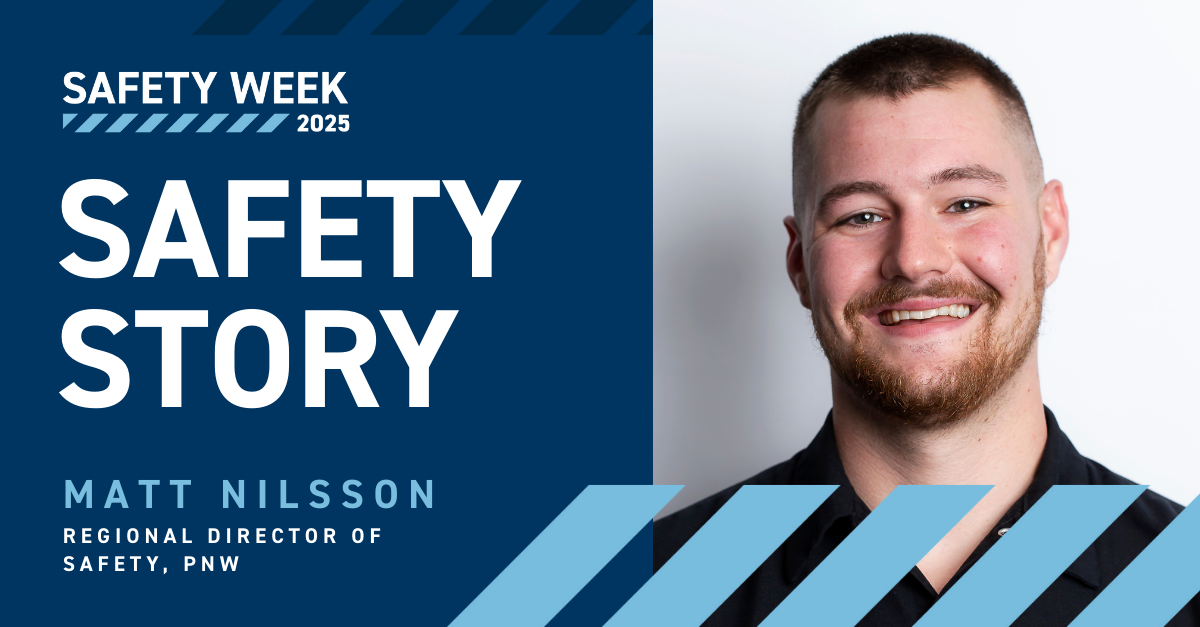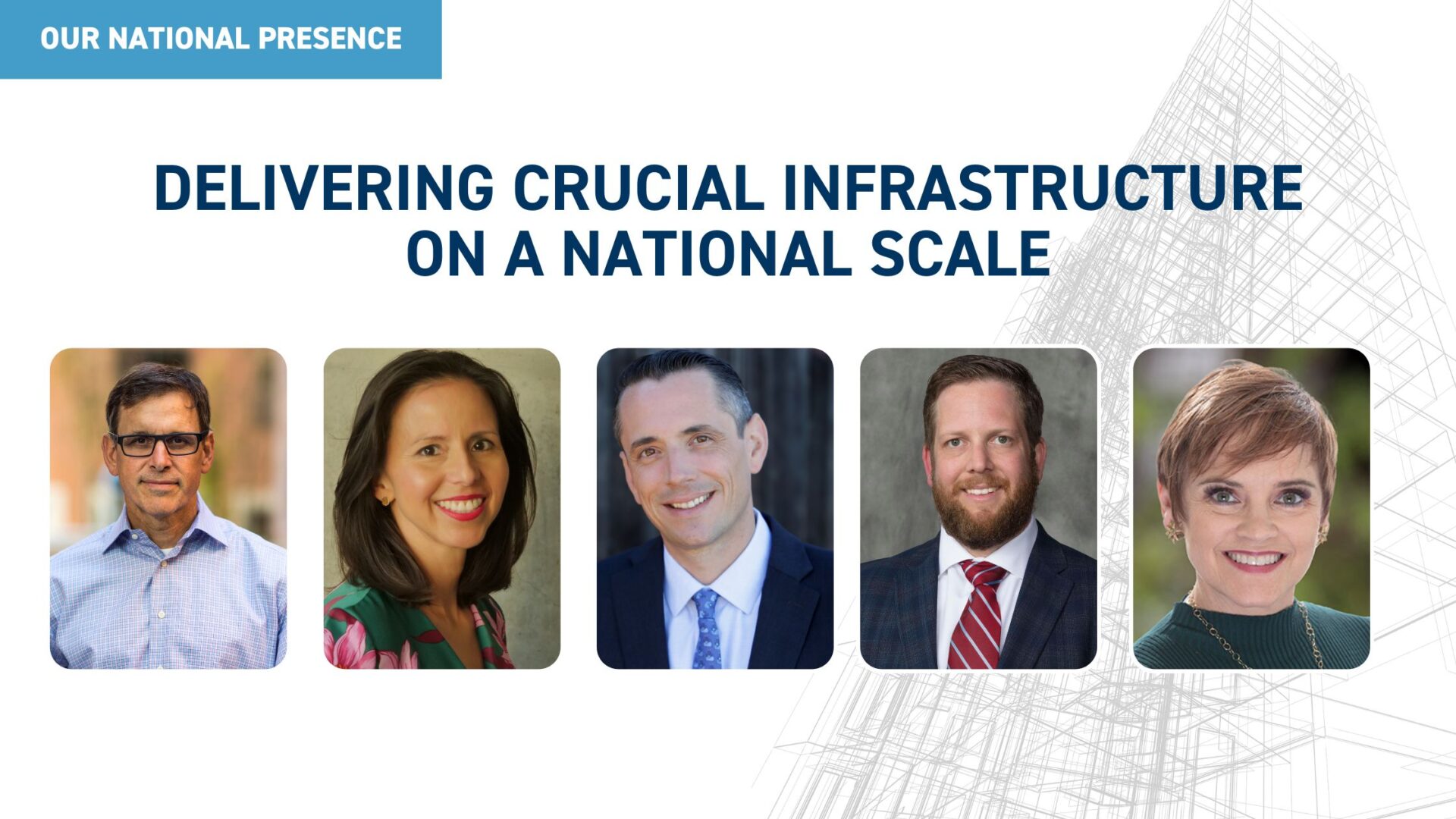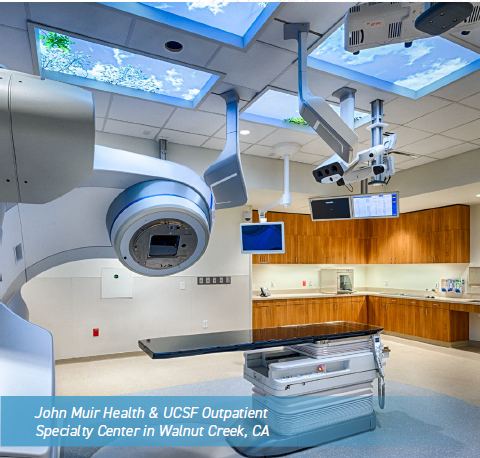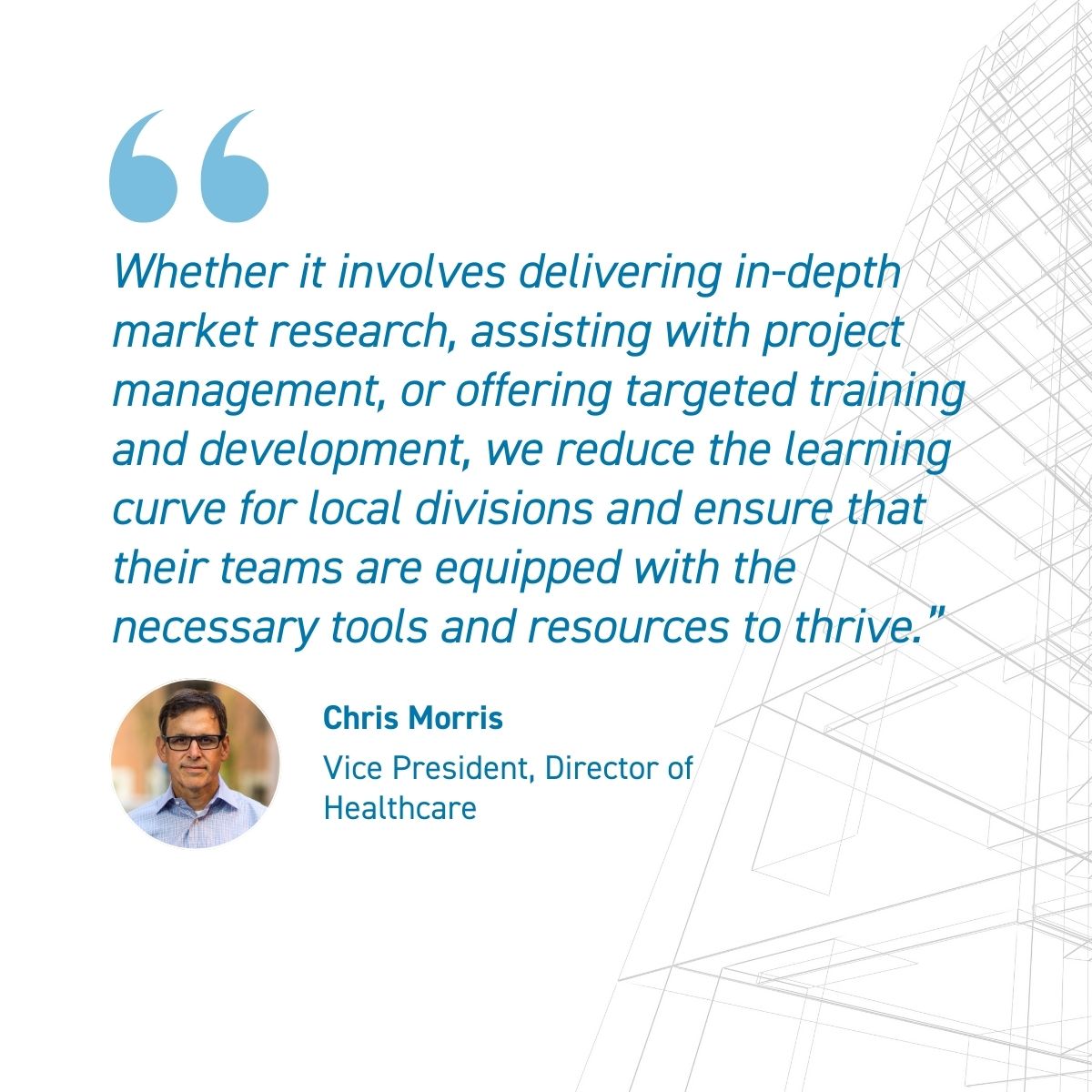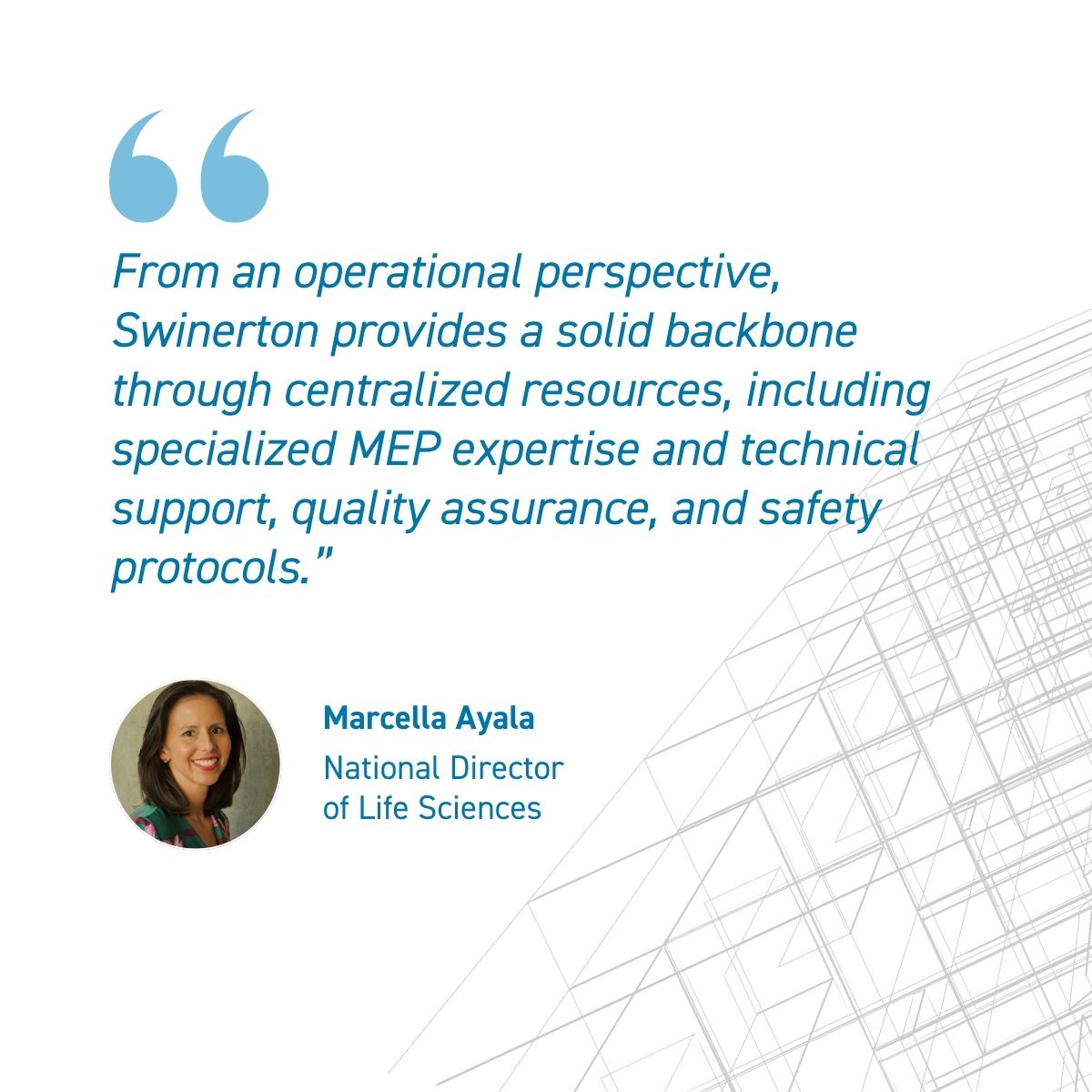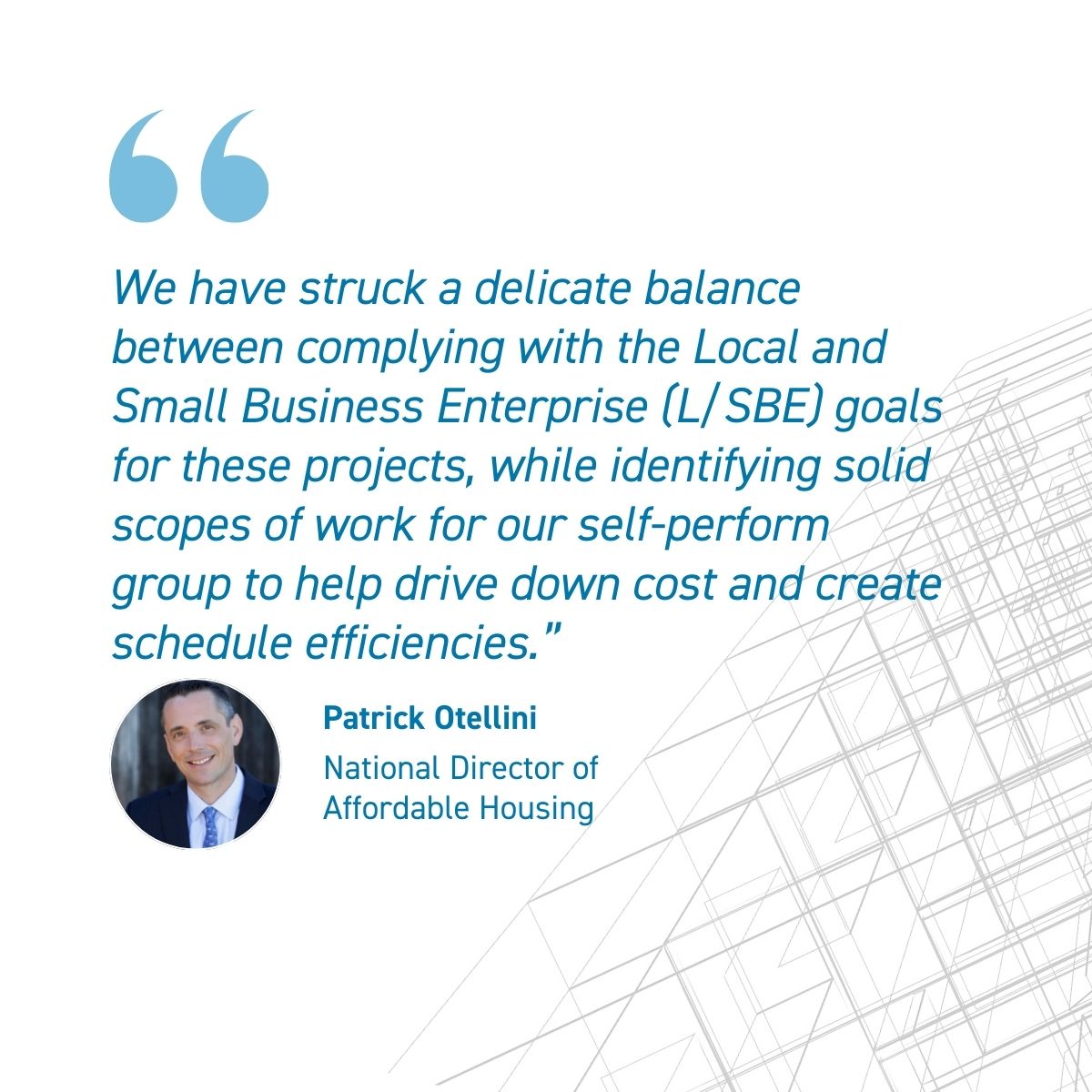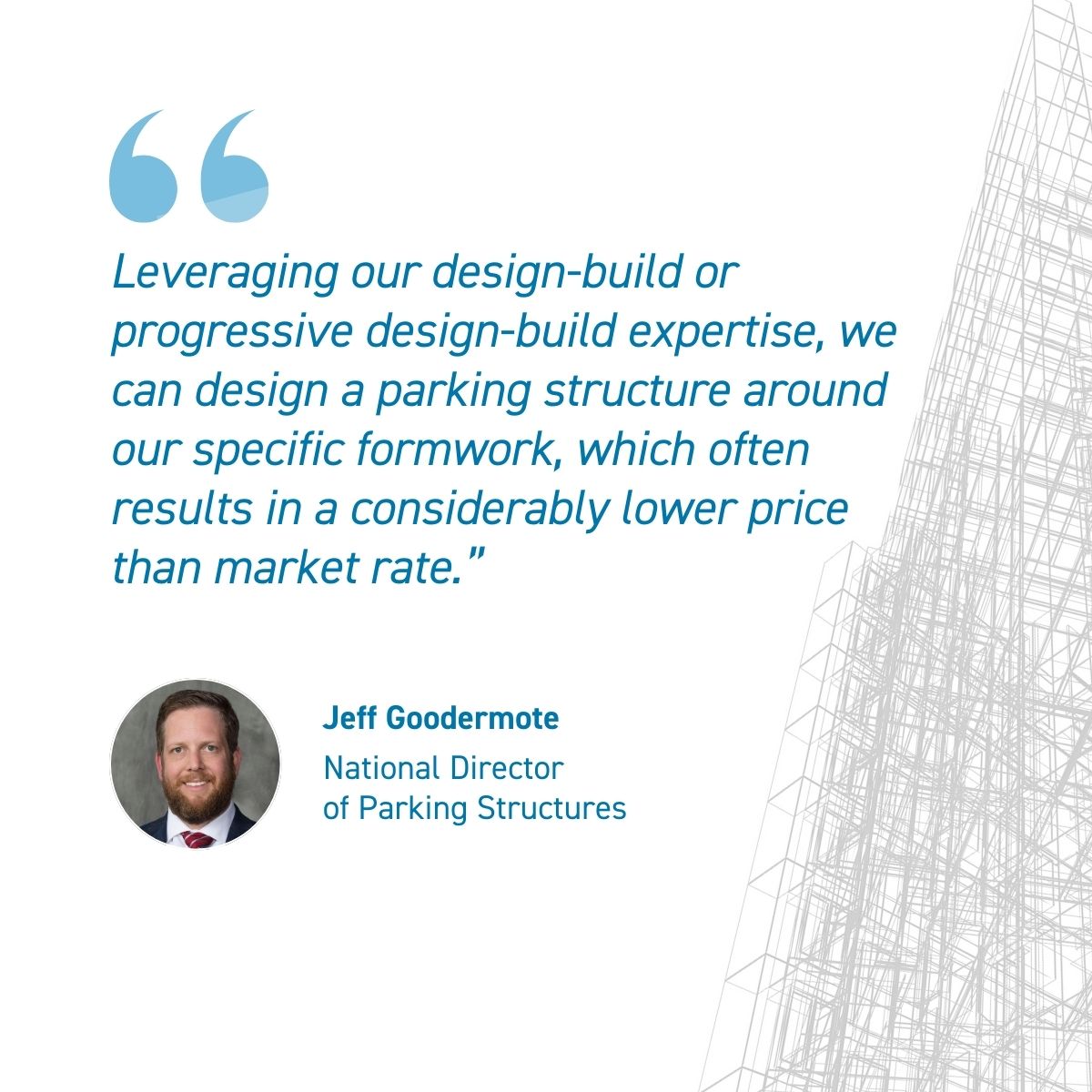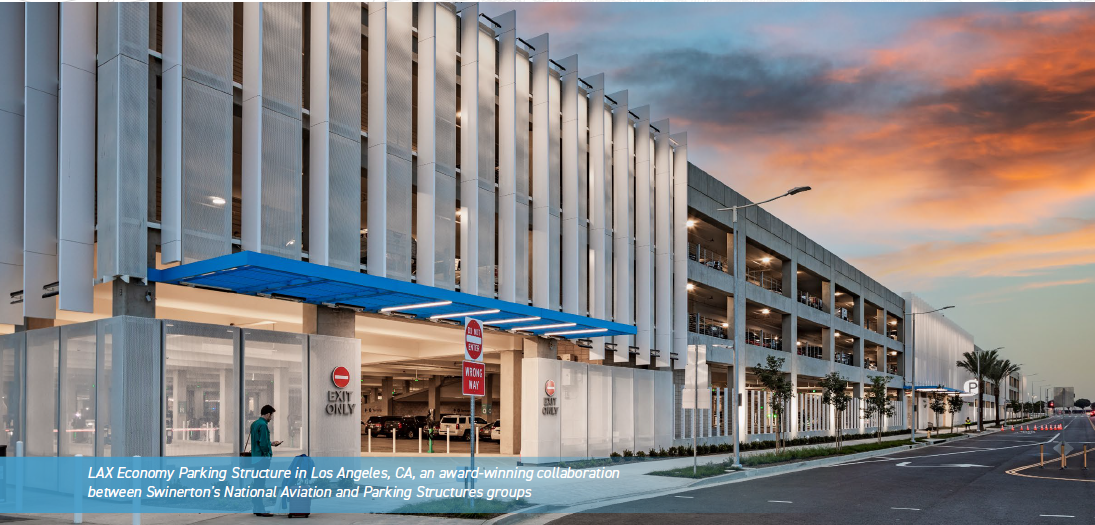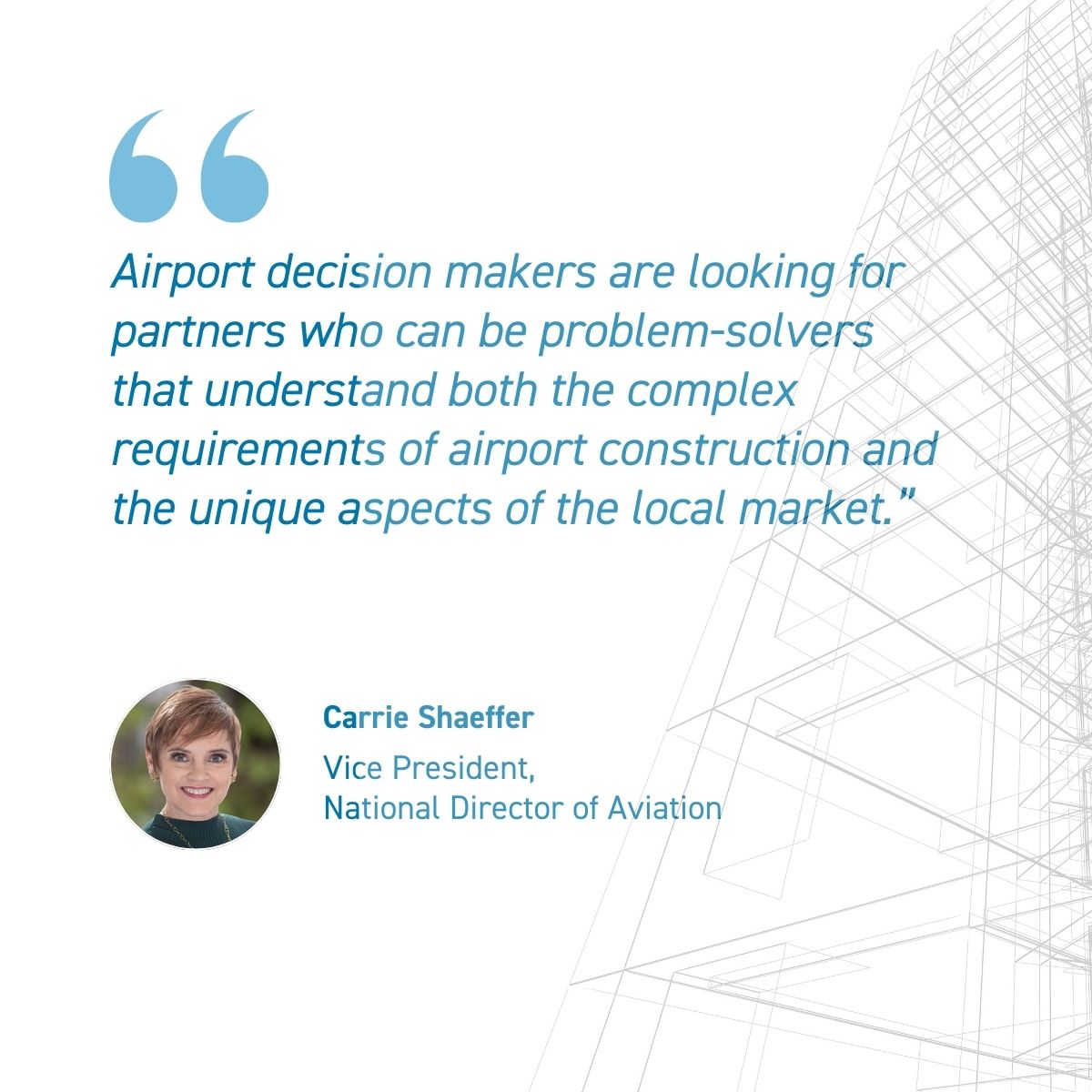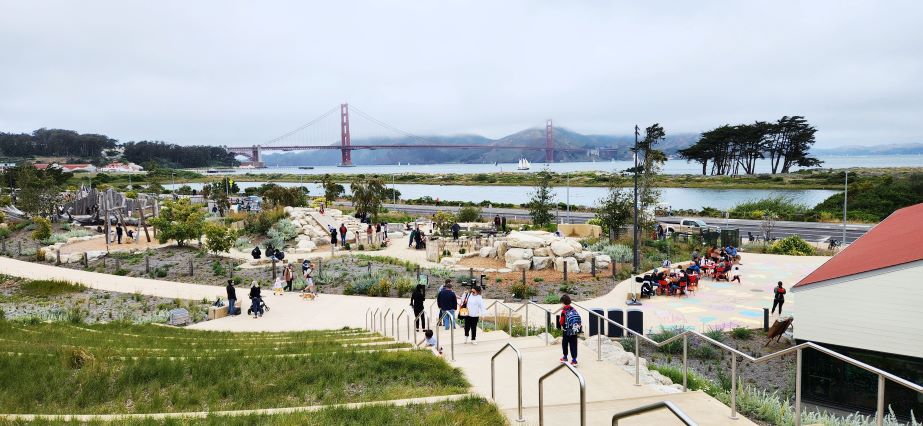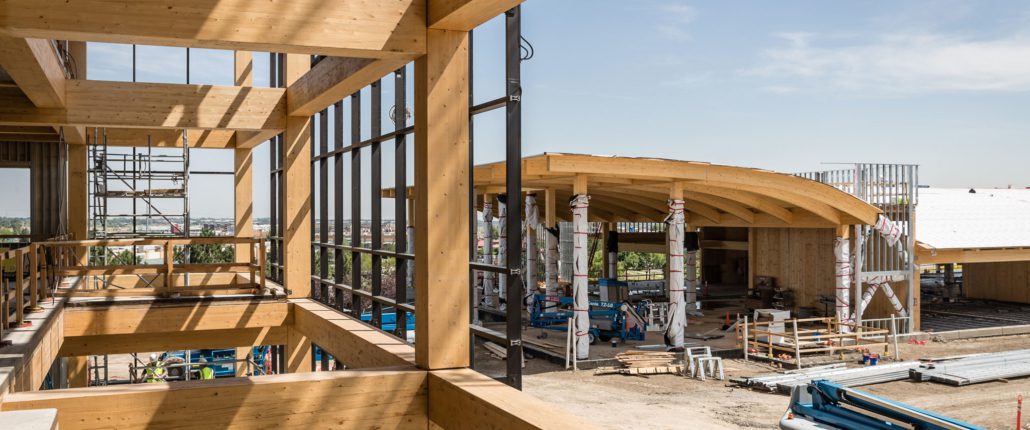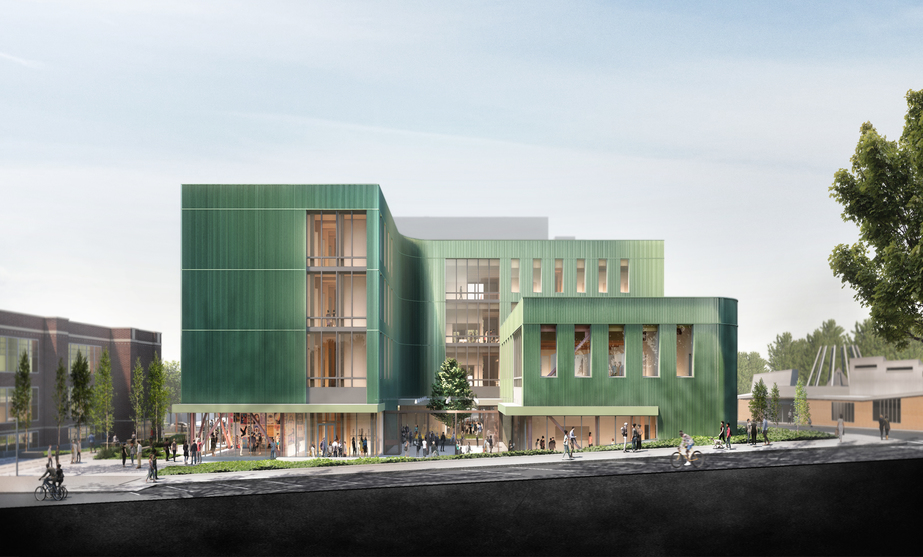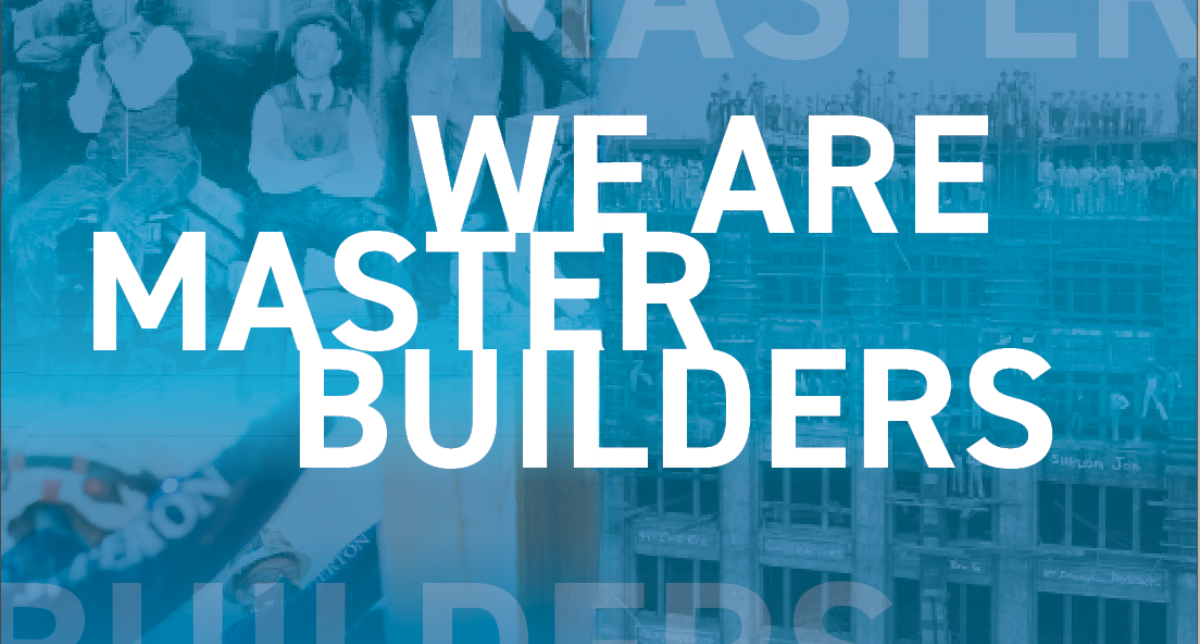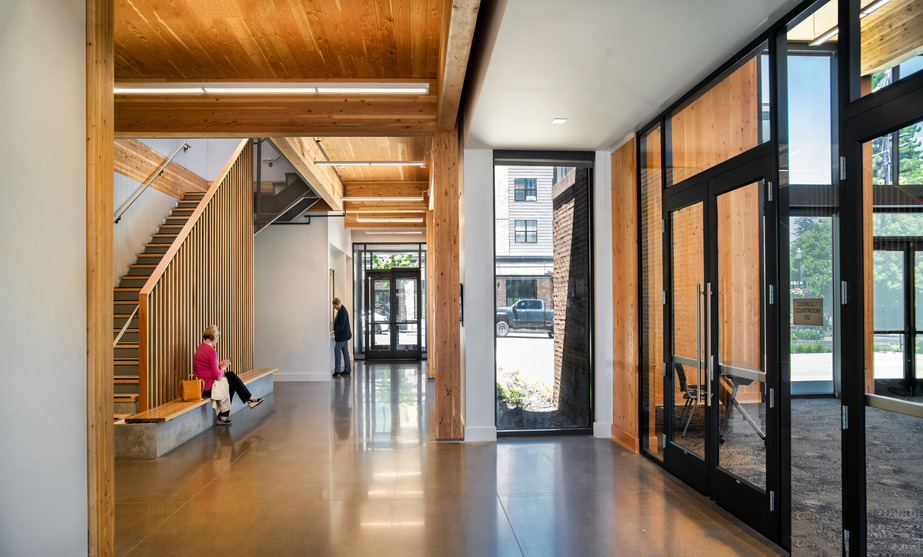Announcing ENR West Northwest 2025 Best Projects Winners
ENR West is pleased to announce the winners for the 2025 Regional Best Projects competition in
the Northwest subregion!
After several weeks of hard work, an independent group of AEC experts reviewed 49 projects from across Washington, Oregon and Alaska to select 15 Best Projects and 18 Awards of Merit. Projects were evaluated on the ability of the project team to overcome challenges, their contribution to the industry and community, safety and construction and design quality.
Award of Merit – Cultural/Worship: Multnomah County Midland Library, Portland, Oregon.
The post Announcing ENR West Northwest 2025 Best Projects Winners appeared first on Swinerton.
]]>The Next Chapter for a Community–Centered Library
Vibrant. Modern. Inclusive. Sustainable. The newly reimagined 30,000-square-foot Midland Library breathes new life into the community of Multnomah County with a warm and inviting atmosphere for all ages.
Cherishing the Past, Preparing for the Future
Recently named the second top public library construction firm in the nation, Swinerton is committed to building impactful spaces for literacy and community. In Portland, OR, Swinerton performed significant renovations to Midland Library, adding 6,000 square feet to the original 24,000-square-foot building via a mass timber and steel hybrid structure in partnership with Timberlab. An eye-catching overhead mural designed by local artists adorns the entire south fa?ade of the building, while three beautiful orange sculptures frame the entry plaza. In addition to the inviting art, several indoor and outdoor gathering spaces allow community members to connect and create.
“Midland Library is one of the county’s largest and most frequented libraries,” says Swinerton Project Manager David Millot, testifying to the importance of the renovation.
Some of the project goals included increasing the amount of meeting and event spaces, increasing the overall space, and improving staff areas and back-of-house areas to accommodate the library’s implementation of its new automated material handling system.
Embracing Mass Timber
Construction on the library began in February 2023 with a gutting of the existing space. The team added underground utilities and completed seismic upgrades to the structure, followed by a new roof, envelope, and interior build-out.
Swinerton’s holistic mass timber partner, Timberlab, came on board as the mass timber supplier and installer. The project team engaged Timberlab early in the design phase to assist with finalizing the building’s structural system, providing new showcase rooms, children’s play areas, and a community patio.
Timberlab constructed angled ceilings and walls that harmonized with the original structure and the new spaces. This created a unified central area for the main book collection, while preserving the original structural integrity.
Midland Library is also pursuing LEED Gold? certification, which is only awarded to the most energy-efficient, cost-effective green buildings.
Project Problem-Solving
The project team faced several challenges throughout the construction process. Permit delays, undocumented underground dry wells, and inaccurate drawings of the original structure added more work than anticipated.
According to David Millot, one of the most significant challenges involved the library’s electrical systems. Within the first few months of the project, the team discovered that the existing electrical equipment did not meet the utility company’s requirements, meaning that entirely new switchgear had to be procured. Complicating the project further, the new switchgear had an exceptionally long lead time, with the potential to derail the entire schedule.
To mitigate the worst of the schedule impacts, the team leveraged the existing building’s power and continued building the new infrastructure needed, which allowed construction to proceed unaffected while the team waited for the new switchgear to arrive.
Additional procurement issues came in the form of the client’s desired high-pressure laminate sliding panels, which needed to be color-coordinated with the artwork on the exterior fa?ade. To produce and procure these custom panels, the team needed to collaborate with a manufacturer in Austria. Although the project team reviewed other panel options that were quicker and easier to procure, they decided to move forward with the desired product rather than risking a conflict with the design intent by procuring too different of a product.
The team coordinated closely with the overseas manufacturing and local jurisdictions to achieve a Temporary Certificate of Occupancy while they waited for the finished panels to arrive. Once the panels were onsite a few weeks later, installation proceeded seamlessly.
Amidst these procurement challenges, David and the project team held weekly meetings and field walks beyond the regular owner-architect-contractor meetings to ensure that any issues could be resolved as quickly as possible. This collaborative process helped the team problem-solve and decide on solutions that met the needs of the library while still meeting the schedule.
Community-Centric Designs
Community members played an integral role in designing the building. Supporting one of the most culturally diverse areas in the region, Midland Library features design input from nine distinct focus groups. The final design draws on a “pattern workshop,” which identified pattern themes of hope, prosperity, strength, and community. These themed patterns and motifs were adapted to the final design and are used throughout the building’s exterior.
Through a partnership with the Regional Arts & Culture Council, 2% of the Midland Library construction budget was allocated to local art. Artists were awarded projects by a selection panel of community members, business owners, artists, project partners, and library staff. Many of the art projects were also guided by the needs and desires of the local community.
A new 750-square-foot “teen space” features large displays and sound systems, enhancing gaming experiences and allowing adolescent patrons to watch movies or video conferences. The outdoor interactive garden has pebble-shaped stepping stones, play mounds, and enclosed views of Midland City Park. A dedicated sensory room includes a space to support self-regulation and decrease stress, while the 10 community rooms spread throughout the library enhance connection.
Outside, new power and water connections allow for food carts, cultural festivals, and resource fairs throughout the year. Accessible bookshelves accommodate users of all physical abilities, while the natural lighting throughout the library promotes connection to nature.
The renovation has centered the library’s role as a gathering place for all ages within Multnomah County.
Enhancing the Greater Multnomah County Library System
The Midland Library is just one part of a robust library refresh program that Swinerton is performing throughout Portland. Once complete, the program will deliver 10 state-of-the-art libraries—some newly renovated, others built from the ground up—but all encompassing the voices of Multnomah County’s diverse community members. Each library blends architecture with artistic elements that reflect the area’s vibrant multicultural communities, emphasizing the significance of people and relationships.
The world depends on human connection, and libraries are spaces where these connections can form and thrive. Midland Library is dedicated to bringing people together, creating bonds, and fostering community, and Swinerton is proud to have helped bring this impactful vision to life.
The post The Next Chapter for a Community–Centered Library appeared first on Swinerton.
]]>New Art Building’s mass timber frame rises on SW Broadway
An innovative mass timber structure is rapidly redefining the Portland State University campus, with the new home for the Schnitzer School of Art + Art History + Design on track for a 2026 completion. Rather than the typical steel and reinforced concrete, the three-story building utilizes mass timber – engineered wood components produced through cutting-edge building technology – resulting in a structure that is both environmentally responsible and a nurturing facility for this vibrant and creative community.
The first mass timber structure on the PSU campus, the building, located on Southwest Broadway between Shattuck Hall and the Native American Cultural Center, was designed by LEVER Architecture with sensitivity to the surrounding landscape and the larger Pacific Northwest region. All of the wood for the building comes from sustainably managed forests across the Pacific Northwest, with more than half of the wood for the structure’s beams and columns coming from Native-managed forests in Oregon and Washington.
The building’s wooden frame is constructed from cross-laminated timber for the floors, and hundreds of glulam horizontal beams and vertical columns (408 and 353, respectively). Both cross lamination and glue lamination (glulam) fabrication methods result in lower carbon emissions than those generated by typical reinforced concrete and steel structures, and it has the added benefit of storing carbon rather than releasing it into the atmosphere. Mass timber members are considered to be just as strong as those made of steel, and they are relatively fire resistant as well.
Before ever arriving on the construction site at PSU, the mass timber members were processed by Timberlab, where they were pressed, or laminated, and cut through a precise milling process known as CNC. Timberlab’s fabrication included hundreds of mortise-and-tenon connections. The prefabricated wood and more than precut connection points have allowed the installation of the structure to proceed much faster and at lower cost than a traditional concrete and steel building, thanks to careful, detailed planning on the part of the architects and engineers.
“Working closely with the Swinerton and Timberlab team, we coordinated and ‘built’ the structure digitally before construction commenced on site,” said Thomas Robinson, founding principal at LEVER Architecture. “Every element in the building – every piece of mass timber, every conduit, every light switch, every duct – was coordinated with each trade in a digital model, so that the materials could be pre-cut and delivered to the site for faster assembly. This allowed construction to happen incredibly quickly. Timberlab was able to build 27,000 square feet of the first floor structure in ten working days.”
The post New Art Building’s mass timber frame rises on SW Broadway appeared first on Swinerton.
]]>Safety Story: Matt Nilsson
In honor of Safety Week, we sat down with Swinerton employees to find out what safety means to them.
Following his recent promotion to Regional Director of Safety for the Pacific Northwest, Matt Nilsson discusses his journey from Safety Intern to Regional Director, his approach to building a safety culture, and why fostering human connection is at the heart of workplace safety.?Matt oversees safety operations in Seattle, Portland, Spokane, and Boise.
Safety Q&A
How did your journey from intern to director shape your approach to construction safety leadership in Seattle?
I started as a Safety Intern with Swinerton back in 2006 while studying at Central Washington University, where I was pursuing a Bachelor of Science in Safety and Health Management. Most of my internship was spent at the Ilani Casino project, and I fell in love with the company culture immediately. Unlike my colleagues who interned elsewhere, I felt like part of a family at Swinerton rather than just a number.
I actually fell into safety somewhat unexpectedly. I originally wanted to be a police officer and was studying law justice, but quickly realized it wasn’t for me. When I took a construction-focused industrial engineering technology class, something clicked. My professor suggested safety might be a good fit for me, and he was right.
Safety appealed to my protective instinct – I’ve always been someone who prefers working behind the scenes. During my time at Central, I was profoundly affected when an 18-year-old worker was electrocuted and lost his life while working on a ship. That tragedy solidified my commitment to safety work. I never wanted another family to experience that kind of grief. At its core, safety is about being another set of eyes for workers, looking out for them and ensuring they return home to their families each day.
How do you foster open communication within your teams to promote a stronger safety culture?
Safety is never a “check-the-box” function. Every project has unique circumstances that require different safety strategies. The key is establishing a collaborative planning process that begins well before construction starts.
We focus on pre-planning with the project teams, particularly with Superintendents. We sit down together to review the schedule and develop Job Hazard Analyses (JHAs) for all Swinerton tasks and high-hazard subcontractor activities. This collaborative approach gives everyone a holistic understanding of what requires our focused attention.
I’m a strong believer in overcommunicating the “why” behind safety practices. When project teams understand the reasoning, they’re more equipped to foster that culture and implement safety practices in the field. We also work extensively with trade partners – especially smaller ones who might not have their own safety personnel – to coach and mentor them. My goal is to make the entire industry safer, one project at a time.
For me, safety isn’t about being the “safety cop” who’s just looking to write people up. I’m a safety professional focused on coaching and mentoring both our people and our trade partners. I can’t expect everyone to know every standard because, even after years in this business, I’m still learning. By taking this educational approach, we improve safety standards across the industry.
How does Swinerton’s approach to both mental and physical well-being contribute to a safer work environment?
Mental Health Awareness is something I’m passionate about. In Seattle, we partner with Associated General Contractors (AGC), and I’ve worked closely with Mandi Kime, AGCW Director of Safety, who heads up mental health awareness initiatives for AGC of America. We’ve brought her to various projects and department meetings to provide training on mental health awareness.
At Swinerton, we create toolbox talks specifically focused on mental health awareness for our craft workers and project staff. During Safety Week (May 5-9), we conduct daily talks rather than our usual weekly toolbox talk, with most focused on mental and physical well-being.
But sometimes it’s the simplest things that matter most, i.e. stopping to have a genuine conversation with craft workers, asking how they’re doing, and showing appreciation for their work. Construction has traditionally had the mindset of being tough and hiding feelings, but the industry is doing a fantastic job debunking that myth.
We also incorporate physical well-being initiatives. In our office, a group of us take walks around the building every few hours – just taking a break, enjoying the sunshine, and mentally checking out from work for those five minutes can make a huge difference.
What safety practice do you consider most essential?
Getting back to the safety basics. At Swinerton, we’ve found that focusing on the fundamentals consistently is what truly keeps people safe day in and day out.
Our Safety Program rests on a firm foundation of effective, industry-recognized strategies that promote safety and wellness on and off the jobsite. Through comprehensive safety plans, meticulous pre-planning, ongoing training, and daily mentoring, we maintain incident rates substantially lower than industry averages.
We emphasize clear communication when identifying, analyzing, and preventing risks. Our findings are shared with management, staff, supervisors, and workers to ensure continuous improvement in safety practices. Through ongoing assessment and planning of the jobsite and the site’s safety plan, we adjust for real-world conditions, whether large or small.
How do you recognize and show appreciation for team members who demonstrate safety excellence?
In the Pacific Northwest region, we recently started a recognition program featuring special lime green high-visibility shirts with the “Your Family Needs You” (YFNY) logo. These shirts stand out from our standard orange ones and are awarded to employees who go above and beyond with safety. The two individuals in a recent photo I shared on LinkedIn received these shirts after they used their Stop Work Authority to intervene when they saw a subcontractor employee getting dangerously close to a power line while operating a lift. They stopped the work before an incident occurred. Along with the shirt, we send a thank-you letter to their home, signed by our Division Manager and Operations Manager, expressing appreciation for their commitment to safety.
On specific projects, we also implement various recognition programs – from monthly crew recognition with lunch and photos displayed on the jobsite to supervisors carrying gift cards to distribute when they see good safety practices. Some clients even get involved, like the Tulalip Tribe recently hosted a barbecue just to thank everyone for working safely while not disrupting casino operations.
These recognition efforts are about creating a positive safety culture. Many companies misunderstand safety as only being about write-ups and negative consequences, but we take a positive approach – recognizing our people for doing things the right way.
?
The post Safety Story: Matt Nilsson appeared first on Swinerton.
]]>As a community contractor with national reach, Swinerton understands the unique demands of building some of our society’s most impactful and widely used infrastructure, including healthcare and life sciences facilities, housing for our vulnerable populations, and transportation hubs. Through vertical leadership and resources, we deliver the consistency and efficiency these market sectors require.
From our earliest days, Swinerton has lent our flexibility to a diverse array of product types and clients: from rebuilding hotels and commercial districts after natural disasters, to our expansion into complex industrial projects in the 20th century, to solidifying our place as a modern-day industry leader in sustainable mass timber construction.
Today, Swinerton is proud to provide premier commercial construction services to nearly 20 market sectors. Several of these markets—including Healthcare, Life Sciences, Affordable Housing, Aviation, and Parking Structures—comprise a large portion of our portfolio in multiple regions nationwide, necessitating centralized resources. These sectors are also essential to our daily lives, serving our society’s needs for health, shelter, and transportation.
To address the unique demands of these markets, Swinerton has centralized its resources and appointed National Market Leads to guide the overall focus and approach, enhance the consistency of project delivery from region to region, and reduce onboarding time for project teams by equipping them with the right training, resources, and processes to deliver on specialized market-specific needs.
To address the unique demands of these markets, Swinerton has centralized its resources and appointed National Market Leads to guide the overall focus and approach, enhance the consistency of project delivery from region to region, and reduce onboarding time for project teams by equipping them with the right training, resources, and processes to deliver on specialized market-specific needs.
“A national approach enables effective management, ensuring that we allocate resources where they are needed most,” says Chris Morris, leader of Swinerton’s National Healthcare market. “Recognizing that each division has its unique strengths and challenges, our team provides tailored support to address these specific needs. Whether it involves delivering in-depth healthcare market research, assisting with project management, or offering targeted training and development, we reduce the learning curve for local divisions and ensure that their teams are equipped with the necessary tools and resources to thrive.”
While projects across the country will always have regional considerations, such as different code requirements and jurisdictional agencies, many markets also have specific inherent industry needs that must always be considered no matter the project size, location, or complexity. For example, research-focused clients often operate in regulated, complex industries and require partners who understand the critical nature of their work, says Swinerton’s National Life Sciences Director, Marcella Ayala.
“From an operational perspective, Swinerton provides a solid backbone through centralized resources, including specialized MEP expertise and technical support, quality assurance, and safety protocols. These resources ensure that no matter where our Life Sciences clients’ projects are located, they receive the same high level of service and technical excellence that their industry demands,” Marcella adds.
As clients seek to answer what is next for their growth—whether rapidly expanding their own operations, or advancing their industry with new innovations—having a national, enterprise construction firm with the capabilities to answer a diverse set of needs is critical.
In addition to national quality and safety programs and centralized MEP expertise, Swinerton is capable of self-performing some of the most critical trades that drive a project, including concrete and drywall. In addition, the firm brings extensive mass timber expertise alongside the partnership of its mass timber affiliate, Timberlab. These capabilities can help drive cost and schedule efficiencies for many market sectors, but have proven especially valuable for affordable housing, where budget, community engagement, and sustainability are at the heart of nearly every project.
“Self-perform plays a huge role in this work,” says Patrick Otellini, Swinerton’s National Affordable Housing Director. “We have struck a delicate balance between complying with the Local and Small Business Enterprise goals for these projects, while identifying solid scopes of work for our self-perform group to help drive down cost and create schedule efficiencies. We also interface a lot with Timberlab, since many of these clients are looking at ways to build more sustainably.”
Recently, a Seattle-based architect who helped author changes to the 2021 International Building Codes (IBC) collaborated with Swinerton and Timberlab to build Seattle’s first mass timber mid-rise workforce housing structure under the new codes. The partnership testifies to how Swinerton’s integrated offerings are not only advancing the future of certain market sectors, but the construction industry as a whole.
Swinerton’s ability to self-perform work is also critically tied to the success of one of its largest national platforms: parking structures. Rather than a market in and of itself, Director of Parking Structures Jeff Goodermote refers to the structures he constructs as a specific “product” that intersects with and supports every other market that Swinerton works in.
“The parking structures sector is a little different from other market sectors, which may include different product types all under one umbrella. For example, aviation has landside and airside operations. Healthcare has acute and non-acute facilities. Compared to those markets, parking is a truly specialized, niche field,” Jeff says.
The group’s complete expertise in parking structure products can be largely attributed to the success of Swinerton’s self-perform concrete group, he adds.
“We have invested in a substantial amount of self-owned concrete formwork that is specific to concrete parking structures. Leveraging our design-build or progressive design-build expertise, we can design a parking structure around our specific formwork, which often results in a considerably lower price than market rate,” Jeff continues. “We have even shipped our formwork over the Pacific Ocean to deliver concrete projects in Hawaii. In addition to our extensive collaboration with our self-perform concrete teams, we are beginning to engage our drywall teams to self-perform some of the fa?ade treatments of our parking structures to round-off our thorough, end-to-end expertise in this product type.”
Over the past decade, the National Parking Structures group has delivered on a number of aviation parking structures throughout California and Colorado, not only bolstering its own portfolio but also the project experience of the National Aviation group. This has been a catalyst for success in other divisions, such as Texas and the Southeast. Additionally, intergroup collaboration between Swinerton’s national market platforms allows the firm to leverage its focus on enhanced efficiency, knowledge-sharing, and commitment to drive value by bridging often-fragmented scopes of work.
“Airport decision-makers are looking for partners who can be problem-solvers that understand both the complex requirements of airport construction and the unique aspects of the local market. We are thrilled to regularly partner with other Swinerton target markets like National Parking Structures,” says Carrie Shaeffer, National Director of Aviation.
“Clients benefit from a collaborative approach because we can provide innovative parking expertise and capabilities that also align with the specific nuances of sensitive airport environments informed by our National Aviation group,” Jeff adds.
Modern construction is demanding. Through our national market platforms, Swinerton ensures that our regional teams have the skills, resources, and support they need to tackle projects in a wide range of sectors. Furthermore, our coast-to-coast expertise and capabilities provide opportunities for clients seeking consistency and efficiency in their project delivery nationwide.
The post Delivering Crucial Infrastructure on a National Scale appeared first on Swinerton.
]]>Best in Design: Swinerton Projects Earn Top Honors in Global Architecture Competition
Four Swinerton projects received recognition in The Architect’s Newspaper’s 2024 Best of Design Awards. The 12th annual competition, which expanded internationally this year, drew the highest number of submissions in program history.
The winning Swinerton projects include:
? Kaiser Watts – Healthcare Category
? Kresge College Residential Building – Higher Education-Residential Category
? PDX Main Terminal – Aviation Category
? Presidio Tunnel Tops – Landscape Category
These awards showcase Swinerton’s commitment to delivering innovative solutions across diverse market sectors. The recognition reflects the technical expertise and dedication of our project teams in creating spaces that serve their communities.
The post Best in Design: Swinerton Projects Earn Top Honors in Global Architecture Competition appeared first on Swinerton.
]]>Mass Timber Buildings: A New Approach to Sustainability and Net Zero Goals
Mass timber is quickly becoming a solution as the number of public institutions and private developers pledging to attain net-zero carbon emissions increases. Whether they are leaning on public-private partnership (P3) or traditional delivery methods, owners and developers are recognizing the benefits of wood as a versatile, sustainable, and structurally efficient feature for their projects. With public and private support for this renewable resource, experts believe mass timber could challenge steel and concrete as favored construction materials.
“Mass timber offers cost and value considerations that developers and clients see as benefits. Mass timber supports regional economies, saves time on the speed of construction, and is a renewable resource—with the added benefits of improved daylighting and interior aesthetics, which benefits the health and well-being of the end-user as well,” said Swinerton Builders (Swinerton) Pacific Northwest Regional Director of Preconstruction William Silva.
For example, at Northlake Commons, the utilization of mass timber estimates 1,990 metric tons of avoided CO2e (carbon dioxide equivalent) emissions, with a total carbon benefit of 2,920 metric tons; this is equivalent to removing 558 cars from the road or to the energy required to operate 249 homes for an entire year. It is also estimated that forests in the U.S. and Canada can regrow the equivalent wood volume in four minutes.
Swinerton’s early commitment to mass timber began in 2016 with the design, permitting, and construction of the then largest mass timber office building in the U.S.—First Tech Federal Credit Union Oregon Corporate Campus—which was delivered four months faster and four percent cheaper than structural steel.
In a short period, Swinerton has become known for taking on and successfully delivering some of the most challenging mass timber projects in the country. With the number of mass timber projects expected to double every two years, Swinerton has assembled an unparalleled knowledge base and robust internal resources that are sought after by design teams and owners who want to capitalize on the lessons learned from other projects.
While building designs will continue to push toward net zero energy, reducing operational carbon through better energy efficiency and cleaner energy sources, there is growing policy and regulation emphasizing the importance of reducing the embodied carbon of our infrastructure as well. Structure and foundation make up over half of a building’s embodied carbon footprint, so they are often targeted first for reductions. Every metric ton of wood used in place of concrete and steel in the structure is estimated to avoid 3.9 metric tons of CO2 emissions, and this is compounded by the fact that mass timber buildings are lighter and reduce the carbon (i.e., concrete) in the substructure.
Life-cycle assessment (LCA) is the industry tool for evaluating the embodied impacts of a building design, but what it cannot account for is the potential carbon “storage vault” mass timber infrastructure offers cities. Mature forests are maximizing their carbon storage, while growing forests are maximizing their carbon sequestration. By sustainably harvesting trees off the landscape and storing that carbon in wood structures for the life of the buildings, forests are allowed to sequester carbon more rapidly from the atmosphere and avoid releasing a large portion of the carbon stored in the removed trees.
While the softer benefits of mass timber, sustainability, and aesthetics frequently lead project teams to want to use a mass timber solution, the construction benefits are often what enables them to happen.
Swinerton recognizes the challenges of developing a project around a new structural system and brings its expertise to teams seeking creative solutions to make a mass timber project financially viable. Swinerton’s approach is to direct efforts toward reducing overall construction cost through smart and informed selections of not just the structural system but also to look at how to leverage complementary benefits in building mechanical, electrical, envelope, and interior systems to help achieve low energy goals.
“We can control costs through early assessment on project alignment with building code and efficient structural layouts that allow for complementary benefits with other building systems and maximize prefabrication,” added Silva.
Because Swinerton is a national leader in numerous construction market sectors, it combines market sector knowledge with mass timber advantages to bring beneficial outcomes for its clients. Swinerton has pioneered mass timber solutions in market sectors, including affordable housing, aviation, civic, community college, corporate accounts, healthcare, higher education, life science, office and more.
5 Examples of Swinerton’s Mass Timber Project Experience
Northlake Commons, Seattle, WA
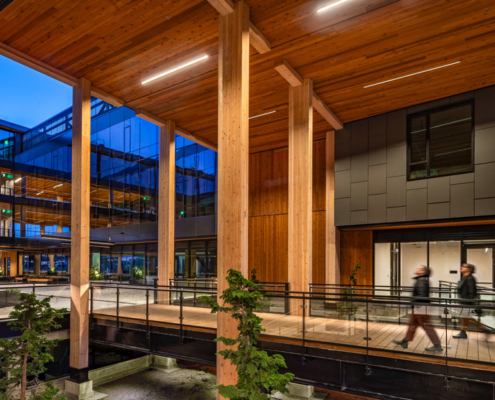
Swinerton’s Northlake Commons highlights the sustainability of mass timber in workplace construction. This 275,000-square-foot, LEED? Platinum-certified building incorporates mass timber columns, beams, and cross-laminated timber (CLT), showcasing how renewable materials can support both structural durability and environmental responsibility. Built in collaboration with Timberlab, a Swinerton affiliate, Northlake Commons’ timber was carefully chosen for its capacity to age beautifully while creating a warm, health-focused environment. Mass timber, significantly lighter than concrete and steel, reduces carbon emissions by up to 75%.
Beyond the use of wood, the building’s design maximizes water and energy savings, contributing to a 27% reduction in electricity usage and conserving over 700,000 gallons of water annually. Further, a significant 96% of construction waste was recycled, minimizing environmental impact. This commitment to sustainable mass timber not only enhances the building’s aesthetic and structural integrity but also reinforces Northlake Commons as a model for eco-friendly development in modern architecture.
Childcare Center, Boise, ID
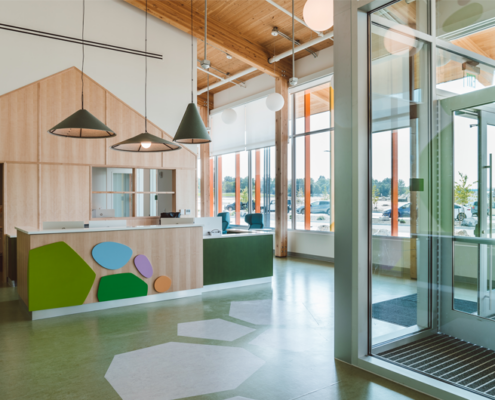
The new 19,347-square-foot single-story childcare center is a groundbreaking example of the benefits of mass timber in early education. Imagine nine lively classrooms with stunning vaulted ceilings, where clerestory windows flood the space with natural light, accentuating the warmth of timber columns and beams. Outside, timber overhangs create inviting play areas, blending seamlessly with nature.
This center isn’t just beautiful—it highlights sustainability. It combines mass timber with additional eco-friendly exterior materials, native landscaping, and cutting-edge energy-efficient features like low-VOC paint, smart thermostats, and LED lighting, seeking to achieve LEED? Gold certification. This innovative approach ensures a healthy, inspiring environment for children to learn and grow.
Sunnydale Community Center, San Francisco, CA
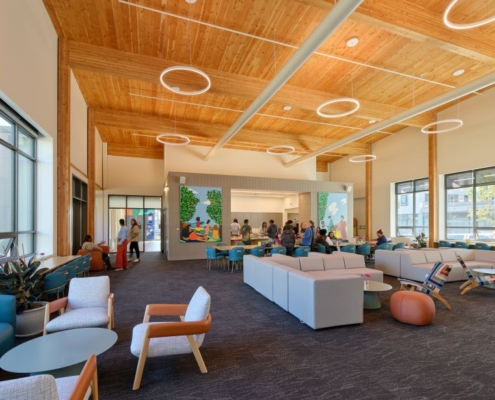
A vibrant new 30,000-square-foot neighborhood community center is a stunning two-story mass timber marvel. It offers a mix of spaces, such as a teaching kitchen, study areas, a recording studio, and a living room for community gatherings. The Sunnydale Community Center also hosts new facilities for Boys & Girls Clubs of San Francisco and Wu Yee Children’s Services, significantly boosting their capacity to provide childcare and youth programs.
Designed for LEED? Gold certification, the center emphasizes sustainability and biophilic design, using CLT and glulam for structural, aesthetic, and eco-friendly qualities. The exposed wood structure not only speeds up construction but also reduces waste and creates a warm, inviting atmosphere.
This project revitalizes the neighborhood, demonstrating the potential of mass timber construction and environmental responsibility with beautiful, impactful construction.
Live Oak Bank Building 4, Wilmington, NC
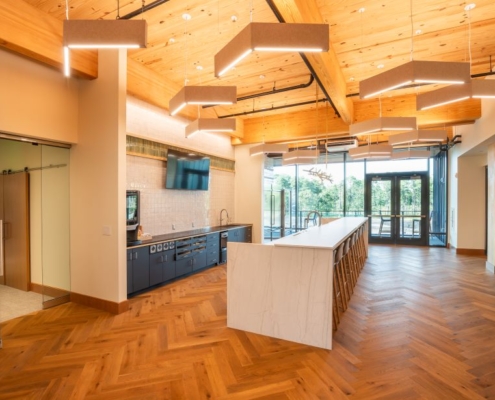 In Wilmington, NC, a new development is welcoming employees—a four-story, 67,000-square-foot constructed entirely from mass timber. This ambitious project is one of the largest of its kind in the United States, slashing the building’s carbon footprint by up to 60%. Nestled among trees and overlooking an expanded pond, Live Oak Bank Building 4 is a harmonious blend of nature and innovation. The design incorporates numerous biophilic elements, aiming to foster a happier, healthier, and more productive work environment. The building is on track to achieve LEED? Silver certification, highlighting its commitment to sustainability and eco-friendly design.
In Wilmington, NC, a new development is welcoming employees—a four-story, 67,000-square-foot constructed entirely from mass timber. This ambitious project is one of the largest of its kind in the United States, slashing the building’s carbon footprint by up to 60%. Nestled among trees and overlooking an expanded pond, Live Oak Bank Building 4 is a harmonious blend of nature and innovation. The design incorporates numerous biophilic elements, aiming to foster a happier, healthier, and more productive work environment. The building is on track to achieve LEED? Silver certification, highlighting its commitment to sustainability and eco-friendly design.Responsive Arts & STEAM Academy, Denver, CO
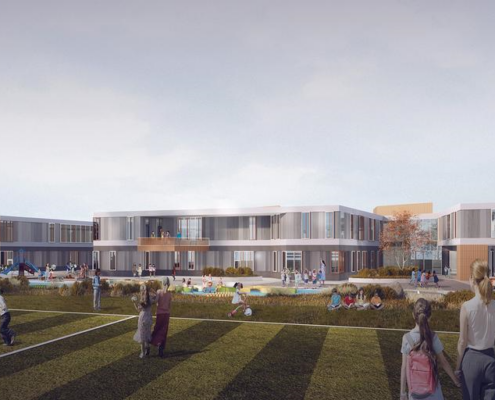
Additional Reading: Contractors are Partners for Achieving Sustainable Development Goals
The post Mass Timber Buildings: A New Approach to Sustainability and Net Zero Goals appeared first on Swinerton.
]]>PSU Marks Start of Construction for New Home for Schnitzer School of Art + Art History + Design
Swinerton is excited to lead the construction of Portland State University’s new Schnitzer School of Art + Art History + Design. The 98,000-square-foot facility, set to open in 2026, will be a key addition to PSU’s campus in the South Park Blocks. This state-of-the-art building will foster creative collaboration among students, faculty, and industry professionals, reinforcing Swinerton’s dedication to building spaces that inspire innovation and community engagement.
The project highlights Swinerton’s commitment to sustainable construction. The building will be the first on PSU’s campus to feature mass timber, a low-carbon alternative to traditional materials. Swinerton’s collaborative approach, working closely with BIPOC student leaders and leveraging equitable design practices, ensures that the new facility will support PSU’s mission of educational accessibility and inclusivity. The design and construction process reflect Swinerton’s core values of leadership, integrity, and passion for delivering projects that impact future generations.
As the Schnitzer School nears completion, Swinerton continues to work alongside PSU and its partners to bring this landmark project to life. By incorporating sustainable materials and prioritizing student input, the project sets a new standard for educational spaces, enhancing PSU’s ability to nurture creative minds and build connections with Portland’s renowned creative industries.
The post PSU Marks Start of Construction for New Home for Schnitzer School of Art + Art History + Design appeared first on Swinerton.
]]>WE ARE MASTER BUILDERS
Swinerton planted roots as a builder 135 years ago, and continues to deepen them nationwide. Alongside our subsidiary companies, we leverage our knowledge, skills, and drive to build the projects and workforce of the future. We take pride in the expertise and passion it takes to raise a structure from the ground up. Because, at our core, we are builders.
A CHANGING INDUSTRY
When brick mason Charles Lindgren founded the company that would become Swinerton at the end of the nineteenth century, the construction landscape looked very different than it does today. The industry was moving from a workforce of individual craftspeople managed by an architect or engineer to a more centralized system. Positions like those of superintendent and foreman emerged to be the expert eyes on the jobsite to manage installation and supervision, while contractor builders brokered materials, labor, and services.
An entrepreneurial mason turned builder, Lindgren saw the potential for greater speed and efficiency as technologies like steel-reinforced concrete emerged on the market. His business partner, Lewis A. Hicks, was a vocal advocate for this technology—writing two enthusiastic articles in 1905 for The Architect and Engineer of California and distributing brochures on the topic to local engineers.
When tragedy struck in the form of the 1906 San Francisco earthquake, Lindgren and Hicks were completely equipped to help rebuild, and could legitimately claim that their steel-reinforced concrete buildings fared better than most in the devastation. Clients who were initially skeptical of the “newfangled” material were convinced. By 1908, when namesake Alfred B. Swinerton joined the firm, the company was well on its way to becoming
one of the most recognized builders in the West, thanks in no small part to its expertise in concrete.
SEEING POTENTIAL
In the century that followed, Swinerton has continually invested in enterprises and people to keep the industry moving forward, expanding its markets and offerings nationally and internationally. From engineering canals and pipelines in the 1950s, driving value-add services like tenant improvements in the 1980s, to embracing sustainable materials and energies in the 2020s, we are always finding ways to build where the world is going.
In 2016, Swinerton recognized another opportunity: to drive construction forward by adopting mass timber. As a result, our mass-timber specialist subsidiary was launched in 2021, harnessing the structural and environmental potential of engineered wood materials and helping clients meet their vision for sustainable structures that soar with the beauty of timber.
BUILDERS OF TOMORROW
Being a master builder depends on first-hand knowledge of the builder’s craft, which must be passed down with each generation. We continue our 135- year builder’s legacy by supporting the workforce of the future: training the next generation of craftspeople in trade skills, and attracting more builders to the industry.
Through The Swinerton Foundation’s support of trade education programs at the Cypress Mandela Training Center in Oakland, CA, Portland YouthBuilders in Portland, OR, and The Roc in Charlotte, NC, partnership with organizations like SkillsUSA nationwide, and outreach efforts at colleges and universities, we are driven to support the young people who will become our next generation of master builders.
OUR BUILDER’S LEGACY
Alongside the industry’s evolution, at Swinerton we continue our master builder’s legacy through the present day, employing thousands of expert craftspeople on staff as laborers, journeymen, foremen, and superintendents whose direct experience in the field ensures our projects’ success. As a company, we invest in their safety, their training, and their well-being to ensure their expertise shines on every project.
Swinerton Builders’ self-perform teams include concrete, drywall, doors, frames and hardware, carpentry, millwork, and demolition and clean-up. Our family of companies also includes a broad range of professionals whose expertise encompass concrete at SAK Builders, mass timber at Timberlab, and engineering, procurement, and construction of renewable gas plants at Swinerton Energy.
On every project, we also draw on our experts who understand the non-physical components of building: financing, logistics, planning, permits, site entitlements, and more. Our administrative teams at Swinerton, Lindgren Development, and Griffin Swinerton work in tandem to make our clients’ buildings possible.
Combined with our expert knowledge and skill, our pride of ownership, passion, leadership, integrity and excellence are what truly make us master builders.
The post We are Master Builders appeared first on Swinerton.
]]>Swinerton Honored with Two Awards of Merit at ENR Northwest 2024 Best Projects
We proudly announce that Swinerton has been honored with two Awards of Merit in the ENR Northwest 2024 Best Projects competition. The projects were recognized for excellence across Washington, Oregon, and Alaska, where entries were judged on innovation, craftsmanship, teamwork, safety, and community impact. These awards highlight Swinerton’s dedication to delivering high-quality projects that positively impact the Pacific Northwest, reinforcing our commitment to leadership and excellence in the construction industry.
A Distinguished Set of Honors
Swinerton’s projects were recognized among the top entries, earning accolades in the Award of Merit category. We are proud to highlight the following honors:
Award of Merit – Government/Public Building: Monmouth City Hall, Portland, OR
Award of Merit – Office/Retail/Mixed-Use: Thesis Headquarters, Portland, OR
The post Swinerton Honored with Two Awards of Merit at ENR Northwest 2024 Best Projects appeared first on Swinerton.
]]>